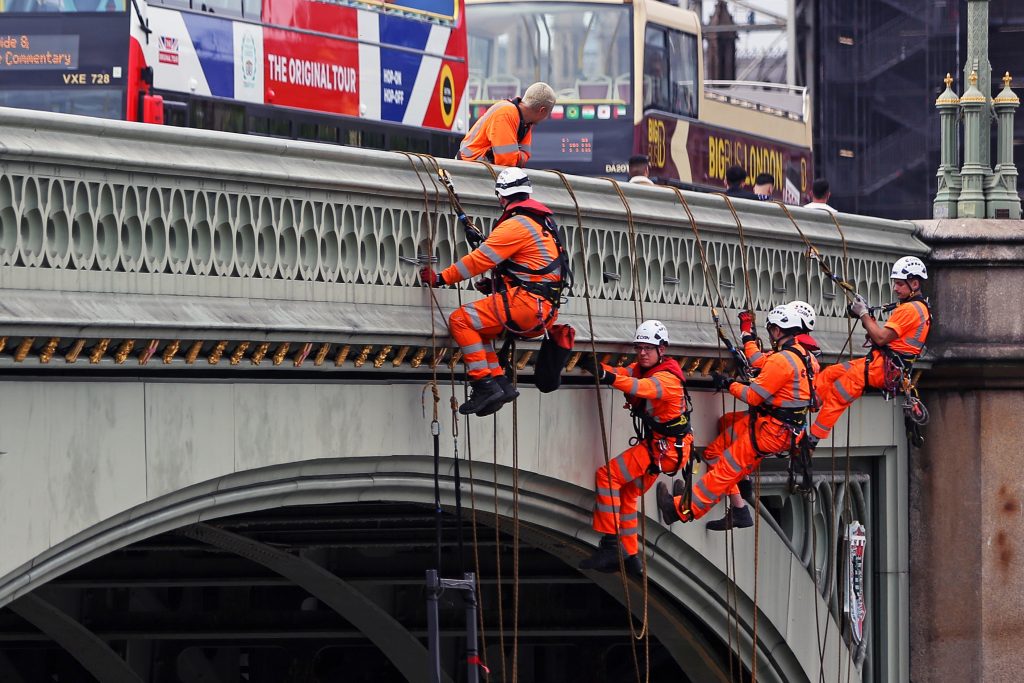Do traditional approaches to bridge inspection and maintenance need a complete “paradigm shift” with increased emphasis on data gathering and analysis?
Maintaining the UK’s bridge infrastructure is a formidable challenge. With ageing assets impacted by increased rainfall and extreme weather events, as well as heavy traffic levels, the structural health of the country’s bridges have long been a concern.
The controversy surrounding London’s Hammersmith Bridge, which remains closed to motorised and pedestrian traffic, is a poignant reminder of how important adequate investment in bridge maintenance and remediation really is. In October, it was revealed that the bridge is set to remain closed to vehicles for another six and a half years.
Hammersmith Bridge: Closed because of weakened suspension chain supports
Hairline fractures in the cast iron “pedestals” which support the saddles that connect the 130 year old suspension bridge’s chain links to the anchorages in its abutments were initially identified in April 2019. Full closure of the bridge was announced in August this year after engineers found those cracks had widened.
It is expected to take several months to understand the condition of all the pedestals, followed by seven months of emergency stabilisation work costing £13.9M, and then 21 months of permanent stabilisation work at a cost of £32M.
Time for action
While the Hammersmith Bridge débâcle will be costly, it has cast a light on the country’s other ageing bridges. With over 3,000 council-managed road bridges across England, Scotland and Wales deemed as “substandard”, according to RAC Foundation research, there are increasing concerns about the condition of these structures.
For bridge owners and engineers, identifying the right methods and techniques that can effectively extend the life of existing assets is crucial. Regular structural maintenance alongside the introduction of a national data log would help the industry to better deliver this objective, according to University of Bristol lecturer in civil engineering and Engineering & Physical Sciences Research Council fellow Maria Pregnolato.
Short term service delivery contracts do not benefit UK PLC
“Establishing a national bridge inventory would help the regular regime of maintenance and the prioritisation of structures for remedial actions at a country level. I think the identification of vulnerable structures in parallel with the understanding of the consequences is crucial for national safety and the economy,” she says.
“Developing and adopting protocols for data collection and maintenance would also facilitate the passage of information from one manager to another to ensure the continuity of management of a structure.”
Better data management could be accelerated by specifying longer term maintenance contracts, with less risk of information being lost from contractor to contractor.
According to London Technical Advisors Group chairman Satbir Gill, longer relationships improve service delivery.
“The longer the contract, the more beneficial it is likely to be for the local authority. And when a new structure is built, the principal contractor should be required to maintain it for an extended period,” says Gill.
“These basic things – good asset management, passing more responsibility to the contractor and longer term service delivery – would be really beneficial.
“Short term service delivery contracts do not benefit UK PLC. Linking these longer relationships to delivering good asset management will be of great benefit.
“This can be achieved through shared risk management and improved risk allocation.”
Asset management
Ultimately, Gill says he is simply a fan of good asset management and extending the life cycle of assets – a view that is shared by WSP executive director and head of civil, bridge and ground engineering Steve Denton.
Denton admits this might not be seen as the most glamorous aspect of the industry’s work, especially compared with the design and delivery of shiny, new structures, but he insists it is some of the most meaningful work bridge engineers are tasked with.
“Throughout my career, the most complex analysis and research work has tended to be oriented towards existing structures, rather than the design of new structures – and that is for good reason,” he says.
“When you are designing new structures, you have more control over the process – you can choose materials and set out your specifications. When you are dealing with existing structures, you have to play the hand you are dealt.”
Solid asset management and understanding the rate of defect progression is nothing new for seasoned bridge engineers. However, Denton believes a paradigm shift is needed in the industry’s approach to bridge inspections.
“Understanding the rate of change of condition is such a valuable piece of information. But the reality is that the way we currently approach the inspection of our structures is oriented towards gaining a snapshot in time,” he says.
“Often we should be more concerned about the rate of change of condition rather than where something is at any one point in time.”
Innovation insight
Improving the tools and processes that are currently used to collect and store information about bridges is an important step towards the “paradigm shift” that Denton speaks so passionately about.
“Let’s look at the data structures we use, how we tag defects, and the ability for inspectors to go out on site with digital tools that augment their understanding.
“We shouldn’t remove that human component, but let’s look at the tools that make it really straightforward for inspectors to look at a structure today while also having access to images and data from when it was last inspected,” Denton says.
“All of these things are possible and are already being done to some extent. I think we now need to focus on how we systemise everything. Let’s start asking some really difficult questions about how we can change our approach so that we can get much better information, because overall it is a fact that the way we currently gather information gives us very poor information for predicting the future.”
Exploring and adopting new technologies from drones to machine learning is key to improving the way the industry captures and uses bridge asset data. Pregnolato says the industry, private sector and research institutes could do more to co-develop technical solutions to incorporate, accelerate and build trust on progress.
“We can’t expect to obtain different results with the same thinking, processes and analysis we have always done,” she adds.
But this level of change requires significant investment. Back in March, the Budget announcement included a £640bn pledge to enhance the country’s roads, railways and housing. Sounds like good news for the nation’s bridges, doesn’t it?
It is a fact that the way we currently gather information gives us very poor information for predicting the future
But since then, the coronavirus pandemic has had an unprecedented impact on the UK economy – casting doubt on how and when the country’s ageing bridge infrastructure will receive a significant investment boost.
So as the purse strings are inevitably tightened, one of the central challenges for bridge engineers will be to better communicate the costs and outcomes of maintenance and remediation. Denton believes this is particularly important when making the business case for public investment.
“For the people making funding decisions, there’s always a balance. Should you spend money on a bridge or is it better to spend it on a hospital? These are some really difficult questions,” he says.
“Therefore, I think it is incumbent on the bridge engineering community to be able to clearly articulate the costs and consequences of different decisions. And then when those funding decisions are made, it is necessary to ensure that we are deploying that investment to sustain our infrastructure as effectively as we possibly can.”
The economic cost of delaying bridge repairs and maintenance is an important message, but it is just as important as conveying the environmental and social impact of failing to adequately maintain these structures. Let us hope that increasing carbon emissions from traffic diversions to longer routes and poorly connected communities are not the legacy of successive governments’ failure to truly invest in existing infrastructure.
Like what you’ve read? To receive New Civil Engineer’s daily and weekly newsletters click here.
















